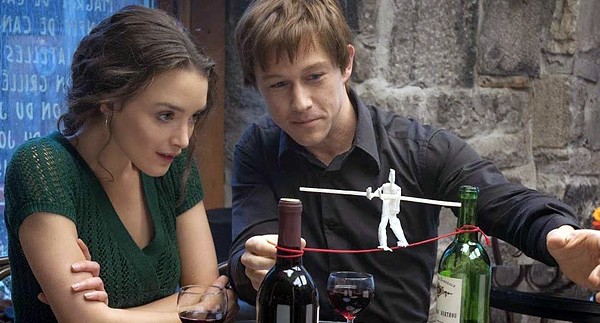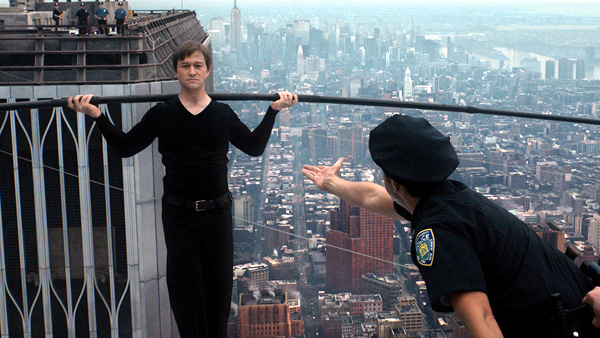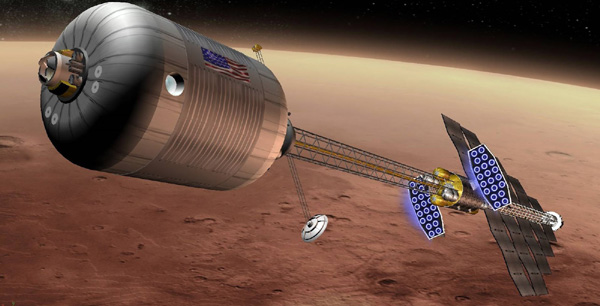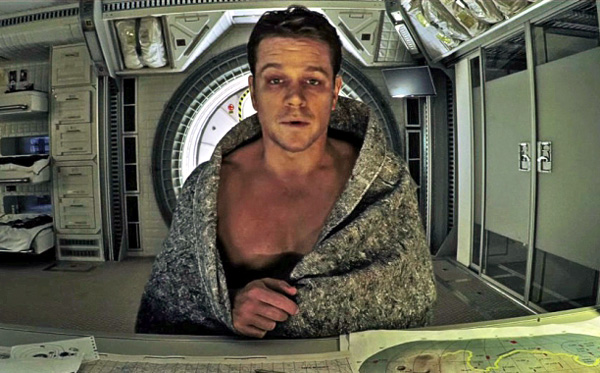|
Two recent films—Robert Zemeckis’ The Walk and Ridley Scott’s The Martian—are special-effects
extravaganzas portraying young men in uniquely perilous situations who must use their wits to save themselves. The Walk is based on the true story of French tightrope walker Philippe Petit, who chose of his own obsessive will to stage a clandestine, illegal walk between the Twin Towers of the newly built World Trade Center in 1974. The
Martian is a totally fictional story, but Scott and his crew make the film seem more real than today’s headlines.
Although it is the film that tells the true story, The Walk seems more frivolous than The Martian. Part of it is that a
45-minute tightrope walk, even one that is a quarter-mile from the ground, pales in significance to being marooned for months on an inhospitable planet tens of millions of miles
from Earth. Much of it, however, is the divergent ways Robert Zemeckis and Ridley Scott choose to tell their tales.
It is instructive, in the case of The Walk, to compare it with Man on Wire, James Marsh’s 2008 documentary about
Petit’s walk between the Twin Towers. Man on Wire gives us Petit and his cohorts in their own words, in what at least seems to be the absolute, unvarnished
truth. Zemeckis, on the other hand, candy-coats the story, at one point literally: whereas Man on Wire shows Petit discovering the plans to build the World Trade
Center in a magazine in a Parisian dentist’s office, The Walk has him go to the dentist after biting down on a brightly colored jawbreaker.
Whereas Man on Wire concentrates on Petit’s walk itself, The Walk presents Petit (Joseph Gordon-Levitt) from childhood,
a middle-class kid obsessed with heights and tightropes from his earliest days. He is a first-class noodge, cocky and single-minded, infuriating everyone he
meets. His parents throw him out; Papa Rudy (Ben Kingsley), his mentor in tightrope walking, begins their acquaintance by attacking him with a pitchfork; Annie (Charlotte
Le Bon), a Parisian street performer whose audience he steals, hates his guts at first, then finally—reluctantly—falls for him.

From the time he reads the magazine article, Petit’s entire life revolves around planning for the day when he can walk between
the Twin Towers. He stages dry runs, such as a walk between the towers of Notre Dame (getting arrested in the process), and
enlists confederates such as boyhood friend Jean-Louis (Clement Sibony) and acrophobic Jean-Francois, a/k/a Jeff (Cesar Domboy). Further co-conspirators come on board once
Philippe arrives in New York: Barry Greenhouse (Steve Valentine), an insurance salesman who happened to see Petit’s Notre Dame walk; J.P. (James Badge Dale), a Francophone
electronics salesman; and the extremely unreliable Albert (Ben Schwartz) and David (Benedict Samuel).

The last half of The Walk is devoted to the subject of its title—the meticulous, clandestine plans leading up to the walk,
and of course the walk itself. The Walk may be the fictional film about Petit’s accomplishment, but it is the one that brings home
the sheer, giddy reality of it, thanks to Zemeckis, cinematographer Dariusz Wolski, and an enormous array of special and visual effects specialists. This extended sequence
had audiences (including this devoutly acrophobic reviewer) watching in horror and awe through splayed fingers, so real did
it seem, never mind that we all knew the outcome. As spectacular as the technical side of this sequence is, a large part
of its success should be credited to Joseph Gordon-Levitt. Gordon-Levitt—who learned tightrope walking from Petit
himself—cinches the reality of the scene with the look of centered, concentrated joy on his face. No one in the history of
the world has ever been so much “in the zone.”
After seeing Man on Wire, however, the rest of The Walk—as accomplished and entertaining as it is—seems a bit of a
whitewash. (The two films’ divergent portrayals of the relationship between Petit and Annie are enough to demonstrate that.) Nevertheless, The Walk is a consistently entertaining,
often heart-stopping film, even if it has a little too much of Zemeckis’ patented jokiness for its own good.
Conversely, despite its location on Mars, The Martian doesn’t
bear all that much resemblance to Scott’s previous outer space epics. Unlike Alien’s Alice Ripley, botanist/astronaut Mark
Watney (Matt Damon) is not confronted with any extraterrestrial predators, unless you can count the uncongenial atmosphere of Mars as one.
The story of The Martian—written by Drew Goddard from a novel by Andy Weir—has all the elemental power of a classic
adventure. A crew of astronauts is investigating the terrain of Mars when a deadly storm suddenly occurs. The force of the
wind drives a screwdriver into Watney’s chest, and he falls motionless to the ground. Mission captain Melissa Lewis
(Jessica Chastain) makes the decision to evacuate immediately. The spaceship blasts off, without Watney’s body.
The next morning, Watney’s body wakes up. His spacesuit prevented the screwdriver from penetrating his chest too far,
and also closed over the blade, preventing his oxygen from escaping.
Old-timers like myself may be reminded at this point of Robinson Crusoe on Mars, a schlocky 1964 sci-fi movie about an
astronaut marooned on the Red Planet. The Martian, however, is in no way comparable to the earlier film except for the basic
concept. With the Tunisian desert standing in for Mars, The Martian is as pure a man-against-the-elements tale as can be
imagined. Watney struggles to keep himself alive in an atmosphere absolutely hostile to human life, with nothing but the shelters and equipment his colleagues left behind.

Scott does a masterful job of emphasizing the perils of Watney’s predicament, with the help of cinematographer Dariusz Wolski
(again!), production designer Arthur Max, and a team of special, visual, and sound effects experts too numerous to mention. At the same time, he makes The Martian about the triumph of
knowledge, science, and the American can-do spirit, beginning with Watney himself.
“I have to grow food on a planet on which nothing can grow,” Watney tells his video diary in a scene already well-known
through the film’s trailer. “Fortunately, I’m a botanist!”

Watney’s tale runs parallel to two others in The Martian. One
involves the ground crew at NASA, scrambling simultaneously to find ways to save Watney and control the inevitable public
outcry caused by the news of an American astronaut stranded in space. The other involves the reaction of Capt. Lewis and her
crew when they are told Watney is alive. Scott and Goddard do wonderfully, with a minimum amount of screen time, to
individualize the characters in these stories and make them recognizably human. It doesn’t hurt that the actors playing
them include Chastain, Chiwetel Ejiofor, Jeff Daniels, Sean Bean, Kristen Wiig and Michael Pena. Donald Glover is a standout; his character may be straight out of The Big Bang Theory, but he
brings him to life, and brings some much-needed laughs in the bargain.
While the public and critical response to The Martian has been overwhelmingly positive, there have been debates in print about
the slant of the film. Some writers have praised The Martian for its lack of spiritual content, condemning Christopher Nolan’s Interstellar for its surfeit of same; others have taken exactly the
opposite view. (It is interesting to note that Matt Damon and Jessica Chastain had major roles in both films.)
The Martian is almost obsessive in its concentration on science; many scientists, including Neil De Grasse Tyson, have weighed
in on the science presented in the film, and found it generally if not totally sound. While I liked the spiritual content of Interstellar, I also believe you have to judge every movie on its
own terms, and on its own terms The Martian succeeds spectacularly. Its closest progenitor is Apollo 13, Ron Howard’s
1995 film about the abortive 1970 moon shot that nearly ended in tragedy for astronauts Jim Lovell (Tom Hanks), Jack Swigert
(Kevin Bacon) and Fred Haise (Bill Paxton). In Howard’s hands, Apollo 13 becomes the story not only of the courage of the
astronauts, but of the brilliance of flight director Gene Kranz (Ed Harris) and his team of engineers in getting the astronauts safely home. The Martian, in essence, is Apollo 13 painted on a larger
canvas. We have the same themes of courage, ingenuity, resourcefulness and teamwork, all presented in a way
guaranteed to make audiences cheer. Even the special effects, as dazzling as they are, are deployed in the service of
emphasizing the heroism and knowhow of these characters.
The box-office tallies for The Martian and The Walk are a study
in contrasts. On the weekend they both opened across the U.S., The Martian earned $9,600 per theater; The Walk, $1,500. The Martian clearly deserved its success, but why didn’t The Walk do better? Perhaps the sheer, terrifying realism of Petit’s walk
was too much for audiences (there were reports of people throwing up in the theater); perhaps they did not respond to the
singularity of Petit’s personality, which one critic described as “cloying.” I hope studio executives will not conclude from The Walk’s dismal box office that Joseph Gordon-Levitt is not a
bankable star, even as I hope that Matt Damon can ride The Martian to a whole new level of stardom.
Postscript: The above review was written before the Nov. 13,
2015 terrorist attacks on Paris. In the light of this horrible tragedy, the irony of reviewing a movie about a French
tightrope walker traversing the space between the Twin Towers of the World Trade Center becomes grim indeed. All I
can say is that my thoughts and prayers are with the people of Paris; with those who continue to live with the scars left by 9/11; and with the victims of terror everywhere.
|